

Bellyboarding is a surface water sport in which the surfer rides a bodyboard on the crest, face, and curl of a wave which is carrying the surfer towards the shore.


Bellyboarding is a surface water sport in which the surfer rides a bodyboard on the crest, face, and curl of a wave which is carrying the surfer towards the shore.
Bellyboarding is the oldest form of surfing from ancient Hawaii & the Polynesian islands. [1] The board design was based on the ancient Hawaiian Paipo boards (Paipo meaning short or small board). In Hawaii people learnt the art of riding prone on these short wooden boards before they attempted to stand up on the longer "alaia" boards. [2]
The boards were made of Gaboon wood or of Paulownia wood. [2]
It appeared in the United Kingdom in the very early 1900s, especially in Cornwall and Devon on the English Channel. It was introduced to the United Kingdom by pioneering Perranporth watermen George Tamblyn and William Saunders, soldiers of WWI in 1918, having been inspired by stories from South African & Commonwealth soldiers they had met and swapped stories with in the trenches. [1] [2]
Tom Tremewan, a relation of George Tamblyn, and the local undertaker, came up with the first bellyboard or surfboard in the UK, made out of coffin lids. These men became the first bellyboard riders of the UK, also known as coffin board or lid surfing.
Bellyboarding bloomed again after WWII as British soldiers returned home. And by rich British people who travelled to Hawai and learned surf and decades later in the 1950s and 60s. [1]
It decreased with the development of bodyboard on polystyrene boards and of actual surfing. [1] [2]
The World Bellyboard Championships, held each year at Chapel Porth in Cornwall, try to revive this sport. The first session took place in 2002 with 20 competitors. Some years later, there were more than 150 competitors also from Australia, USA and the British Virgin Islands. [2]
Generally, the board used in bellyboarding is a thin board of plywood. The nose of the board is up curved up. There are no swin fins. There is no leash because the board is easier to manage and to keep in hand.
Wetsuits are not necessary [1] because the skin is not irritated by the wood, as polystyrene of bodyboards do. [2]

Surfing is a surface water sport in which an individual, a surfer, uses a board to ride on the forward section, or face, of a moving wave of water, which usually carries the surfer towards the shore. Waves suitable for surfing are primarily found on ocean shores, but can also be found in standing waves in the open ocean, in lakes, in rivers in the form of a tidal bore, or in wave pools.

Bodyboarding is a water sport in which the surfer rides a bodyboard on the crest, face, and curl of a wave which is carrying the surfer towards the shore. Bodyboarding is also referred to as Boogieboarding due to the invention of the "Boogie Board" by Tom Morey in 1971. The average bodyboard consists of a short, rectangular piece of hydrodynamic foam. Bodyboarders typically use swim fins for additional propulsion and control while riding a breaking wave.

A surfboard is a narrow plank used in surfing. Surfboards are relatively light, but are strong enough to support an individual standing on them while riding an ocean wave. They were invented in ancient Hawaii, where they were known as papa he'e nalu in the Hawaiian language, and were usually made of wood from local trees, such as koa. They were often over 460 cm (15 ft) in length and extremely heavy. Major advances over the years include the addition of one or more fins (skegs) on the bottom rear of the board to improve directional stability, and numerous improvements in materials and shape.
Tom Hugh Morey, also known by the moniker Y, was a musician, engineer, surfboard shaper, and surfer responsible for several technological innovations that have heavily influenced modern developments in surfing equipment design.

The Waveski, previously known as the "Paddle Ski” is a surfboard where the rider 'sits' on top of the surfboard. Waveski surfing is a dynamic sport combining paddle power with the manoeuvrability and performance of a surfboard. A Waveski resembles a larger volume surfboard, with the addition of a hollowed out seat with seat belt, foot straps and double ended paddle enabling the rider to remain attached to the board for maneuvers and to 'Eskimo roll' if overturned. The waveski rider or surfer uses a double-ended paddle while seated. To turn the rider uses his weight to lean on the side rails and paddle to pivot or propel the board up the wave. The sport is categorized under the International Canoe Federation. The discipline holds biennial World championship events, the next of which will be held at the Nahoon Reef, outside the town of East London, South Africa.

Surf culture includes the people, language, fashion, and lifestyle surrounding the sport of surfing. The history of surfing began with the ancient Polynesians. That initial culture directly influenced modern surfing, which began to flourish and evolve in the early 20th century, with its popularity peaking during the 1950s and 1960s. It has affected music, fashion, literature, film, art, and youth jargon in popular culture. The number of surfers throughout the world continues to increase as the culture spreads.

The riding of waves has likely existed since humans began swimming in the ocean. In this sense, bodysurfing is the oldest type of wave-catching. Undoubtedly ancient sailors learned how to ride wave energy on many styles of early boats. Archaeological evidence even suggests that ancient cultures of Peru surfed on reed watercraft for fishing and recreation up to five thousand years ago. However, standing up on what is now called a surfboard is a relatively recent innovation developed by the Polynesians. The influences for modern surfing can be directly traced to the surfers of pre-contact Hawaii.

A surfboard shaper is someone who designs and builds surfboards. The process of surfboard shaping has evolved over the years, and the shaper often tailors his or her work to meet the requirements of a client or a certain wave. Surfboard shapers can be independent or work in collaboration with mass-production companies.
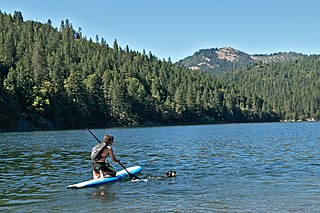
Paddleboarding is a water sport in which participants are propelled by a swimming motion using their arms while lying or kneeling on a paddleboard or surfboard in the ocean or other body of water. Paddleboarding is usually performed in the open ocean, with the participant paddling and surfing unbroken swells to cross between islands or journey from one coastal area to another.
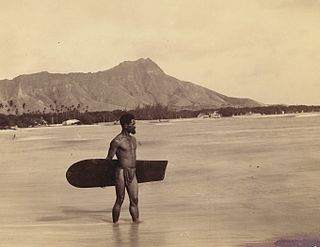
An alaia is a thin, round-nosed, square-tailed surfboard ridden in pre-20th century Hawaii. The boards were about 200 to 350 cm long, weighed up to 50 kg (100 lb), and generally made from the wood of the Koa Tree. They are distinct from modern surfboards in that they have no ventral fins, and instead rely on the sharpness of the edges to hold the board in the face of the wave.
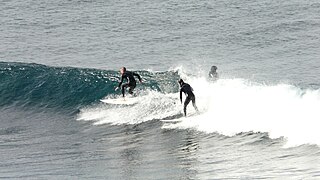
Australia is renowned as one of the world's premier surfing destinations. Surfing underpins an important part of the Australian coastal fabric. It forms part of a lifestyle in which millions participate and which millions more have an interest. Australian surfboard-makers have driven innovation in surfboard design and production since the mid-1960s. The country has launched corporate giants such as Billabong, Rip Curl and Quiksilver.
Dale Velzy was an American surfboard shaper, credited with being the world's first commercial shaper. He opened the first professional surf shop in Manhattan Beach, California, in 1950, personally hand fashioning the surfboards from wood or synthetic material. By 1960, Velzy owned five retail shops and three production facilities in California and Hawaii. He was known as "Hawk" for his keen eyesight.
Donald Moke Takayama was an American professional surfer and surfboard shaper. Originally a longboard surfer, Takayama won the Master's division of the United States Surfing Champions in 1971, 1972 and 1973. Hawaiian born, Takayama learned to surf at Waikiki Beach and moved to California in the mid-1950s. Takayama died of complications from heart surgery; he is survived by his wife and four daughters.

Dog surfing is a type of surfing maneuver involving dogs that are trained to surf on surfboards, bodyboards, skimboards, windsurf boards or to bodysurf. Historically, surfing dogs have been documented as occurring as early as the 1920s in the United States. Competitions and exhibitions that feature surfing dogs have occurred in various coastal areas of the United States, such as Del Mar, California, Imperial Beach, California and Jupiter, Florida.

Surfing in the United States is a popular hobby in coastal areas, and more recently due to the invention of wave pools, inland regions of the country. It contributes to a lifestyle and culture in which millions participate and which millions more have an interest. USA surfing is the governing body for the sport of surfing in the United States, with surf leagues such as the World Surf League available in the country. Surfing can be traced back to 17th Century Hawaii and has evolved over time into the professional sport it is today, with surfing being included for the first time in the 2020 Summer Olympics in Tokyo.
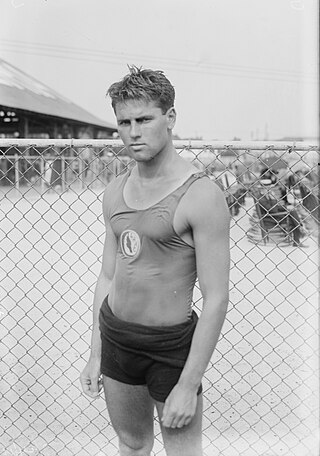
Thomas Edward Blake was an American athlete, inventor, and writer, widely considered to be one of the most influential surfers in history, and a key figure in transforming surfing from a regional Hawaiian specialty to a nationally popular sport. Assessing Blake's significance, sociologist Kristin Lawler wrote that

The Museum of British Surfing is a Museum based in Braunton, Devon; the museum contains exhibits relating to the history of surfing in the United Kingdom.
George Downing was an American surfer based in Hawaii. In 1951, he created the first surfboard with a removable fin.
Horse surfing is an extreme sport invented in 2004. It requires two people, a horse, and a board. Horse surfing involves one person riding either kite-board, surfboard, wake-board, or skim-board, while being towed behind a horse, ridden by a second person, through shallow water, at speeds up to 40 miles per hour (64 km/h). After originating in England the first official horse surfing competition was held in 2006 in La Baule, France, and over the last 14 years the sport has continued to spread internationally. Today there are several competitions with globally established rules and categories.
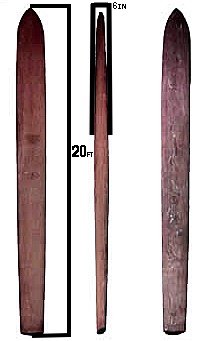
The Olo, Olo board or Olo surfboard is a traditional long Hawaiian surfboard that was used by Hawaiian Chieftains for surfing. The Olo surfboard was the largest out of the three types of traditional surfboards that were used by the Hawaiian people. The Olo is twice as long as the modern surfing longboard, measuring up to 5.18 metres (17.0 ft) long, 16.5 inches wide and nearly 6 inches thick. The board was more than 76.20 kilograms (168.0 lb) and was used for surfing large waves and even tsunamis, the boards were strictly meant for Hawaiian Chieftains and Kings.